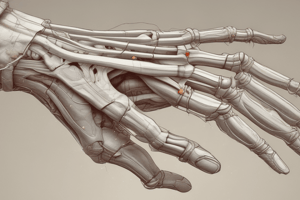Podcast
Questions and Answers
What is the correct terminology for the joint located between the carpals and metacarpals?
What is the correct terminology for the joint located between the carpals and metacarpals?
- Interphalangeal joint
- Metacarpophalangeal joint
- Carpometacarpal joint (correct)
- Proximal interphalangeal joint
Which of the following joints does the thumb not have compared to the other fingers?
Which of the following joints does the thumb not have compared to the other fingers?
- Distal interphalangeal joint (correct)
- Proximal interphalangeal joint
- Metacarpophalangeal joint
- Carpometacarpal joint
In terms of anatomy, what is referred to as a 'ray' in the context of the hand?
In terms of anatomy, what is referred to as a 'ray' in the context of the hand?
- A collection of carpals
- The base joints of the hand
- A set of metacarpals only
- All phalanges and the associated metacarpal (correct)
Which statement correctly describes the relationship between the distal head of the metacarpals and the proximal base of the phalanges?
Which statement correctly describes the relationship between the distal head of the metacarpals and the proximal base of the phalanges?
How many total phalanges does the thumb have?
How many total phalanges does the thumb have?
What distinguishes the orientation of the thumb from the other fingers?
What distinguishes the orientation of the thumb from the other fingers?
What is the keystone of the proximal transverse arch in the hand?
What is the keystone of the proximal transverse arch in the hand?
Which statement about thumb movement is correct?
Which statement about thumb movement is correct?
What do the terms 'flexion' and 'extension' refer to in the context of finger movement?
What do the terms 'flexion' and 'extension' refer to in the context of finger movement?
What is the difference between the radial and ulnar surfaces of the hand?
What is the difference between the radial and ulnar surfaces of the hand?
How do the arches of the hand contribute to its function?
How do the arches of the hand contribute to its function?
Which of the following describes the function of opposition in the thumb?
Which of the following describes the function of opposition in the thumb?
What is the significance of the second and third rays in the longitudinal arch of the hand?
What is the significance of the second and third rays in the longitudinal arch of the hand?
What type of motion do the terms abduction and adduction refer to in the context of fingers?
What type of motion do the terms abduction and adduction refer to in the context of fingers?
What aspect of thumb flexion distinguishes it from finger flexion?
What aspect of thumb flexion distinguishes it from finger flexion?
Flashcards are hidden until you start studying
Study Notes
Hand Anatomy and Terminology
- Fingers are numbered 1-5 starting with the thumb.
- CMC joint: Carpometacarpal joint, located between the carpals and metacarpals, and shortened to CMC.
- MCP joint: Metacarpophalangeal joint, located between the metacarpal and the proximal phalanx.
- IP joint: Interphalangeal joint, can be either distal (DIP) or proximal (PIP), found between phalanges.
Thumb Anatomy
- Thumb anatomy differs from other fingers with only one IP joint.
- Thumb flexion occurs across the face of the hand, with its palmar surface facing medially.
- Thumb's dorsal surface faces laterally, unlike other fingers.
- Thumb's radial surface faces anteriorly, and the ulnar surface faces posteriorly.
- This 90-degree rotation allows for opposition, grasping, and interaction with the fingers.
Hand Arches
- Proximal transverse arch: Located between the CMC joints, with the capitate as its keystone.
- Distal transverse arch: Located between the MCP joints, with the second and third rays as its keystone.
- Longitudinal arch: Located between the second and third rays, with the second and third MCPs as its keystone.
Hand Movements
- Fingers:
- Flexion: Bringing fingers together.
- Extension: Opposite of flexion.
- Abduction (ABD): Bringing fingers apart relative to the third ray.
- Adduction (ADD): Bringing fingers together relative to the third ray.
- Thumb:
- Flexion: Bringing thumb across the face of the hand.
- Extension: Opposite of thumb flexion.
- Abduction: Bringing thumb away from the palmar surface of the hand.
- Adduction: Bringing thumb back towards the palmar surface of the hand.
- Opposition: Bringing thumb across to tap the pads of the fingers.
- Reposition: Returning thumb to the anatomical position.
Arthrokinematics
- First CMC Joint (Thumb):
- Saddle joint with concave longitudinal surface and convex medial-lateral surface.
- Abduction (convex on concave): Roll anterior and slide posterior.
- Flexion and Extension (concave on convex): Roll and slide in the same direction.
- Opposition (two phases):
- Phase 1 (abduction): Roll and slide in opposite directions.
- Phase 2 (flexion/medial rotation): Roll and slide in the same direction.
- Fingers (Digits II-IV):
- Flexion and Extension (concave on convex): Roll and slide in the same direction.
- AB and adduction (concave on convex): Roll and slide in the same direction, mobility decreases with flexion due to tightened collateral ligaments and flattened palmar surface.
- First MCP Joint (Thumb):
- Convex phalanx on concave first metacarpal, roll and slide in the same direction.
- IP Joints (Fingers):
- Mostly convex and concave surfaces with a central ridge preventing rotation.
- Most motion occurs at the MCP joint and not PIP or DIP.
- Flexion and Extension (concave on convex): Roll and slide in the same direction.
- IP Joint (Thumb):
- Only one IP joint.
- Concave on convex surfaces, roll and slide in the same direction.
Studying That Suits You
Use AI to generate personalized quizzes and flashcards to suit your learning preferences.



